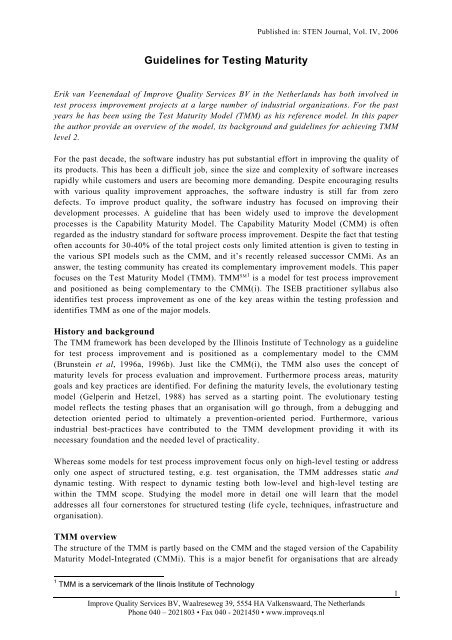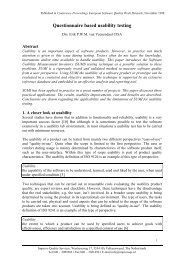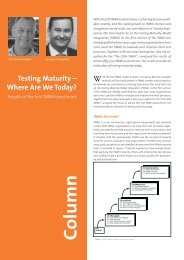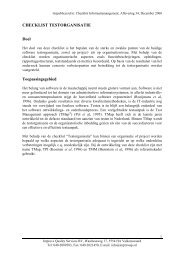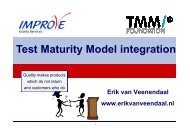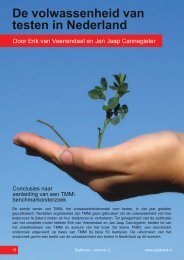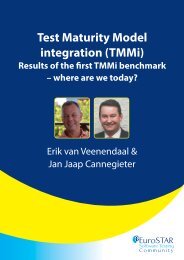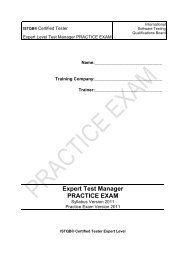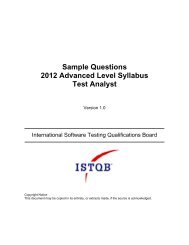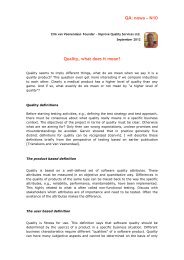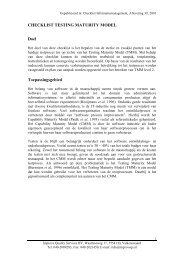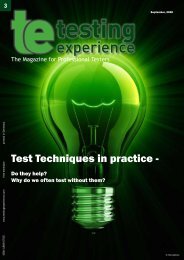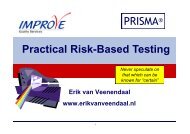Guidelines for Testing Maturity - Erik van Veenendaal
Guidelines for Testing Maturity - Erik van Veenendaal
Guidelines for Testing Maturity - Erik van Veenendaal
Create successful ePaper yourself
Turn your PDF publications into a flip-book with our unique Google optimized e-Paper software.
Published in: STEN Journal, Vol. IV, 2006<strong>Guidelines</strong> <strong>for</strong> <strong>Testing</strong> <strong>Maturity</strong><strong>Erik</strong> <strong>van</strong> <strong>Veenendaal</strong> of Improve Quality Services BV in the Netherlands has both involved intest process improvement projects at a large number of industrial organizations. For the pastyears he has been using the Test <strong>Maturity</strong> Model (TMM) as his reference model. In this paperthe author provide an overview of the model, its background and guidelines <strong>for</strong> achieving TMMlevel 2.For the past decade, the software industry has put substantial ef<strong>for</strong>t in improving the quality ofits products. This has been a difficult job, since the size and complexity of software increasesrapidly while customers and users are becoming more demanding. Despite encouraging resultswith various quality improvement approaches, the software industry is still far from zerodefects. To improve product quality, the software industry has focused on improving theirdevelopment processes. A guideline that has been widely used to improve the developmentprocesses is the Capability <strong>Maturity</strong> Model. The Capability <strong>Maturity</strong> Model (CMM) is oftenregarded as the industry standard <strong>for</strong> software process improvement. Despite the fact that testingoften accounts <strong>for</strong> 30-40% of the total project costs only limited attention is given to testing inthe various SPI models such as the CMM, and it’s recently released successor CMMi. As ananswer, the testing community has created its complementary improvement models. This paperfocuses on the Test <strong>Maturity</strong> Model (TMM). TMM SM1 is a model <strong>for</strong> test process improvementand positioned as being complementary to the CMM(i). The ISEB practitioner syllabus alsoidentifies test process improvement as one of the key areas within the testing profession andidentifies TMM as one of the major models.History and backgroundThe TMM framework has been developed by the Illinois Institute of Technology as a guideline<strong>for</strong> test process improvement and is positioned as a complementary model to the CMM(Brunstein et al, 1996a, 1996b). Just like the CMM(i), the TMM also uses the concept ofmaturity levels <strong>for</strong> process evaluation and improvement. Furthermore process areas, maturitygoals and key practices are identified. For defining the maturity levels, the evolutionary testingmodel (Gelperin and Hetzel, 1988) has served as a starting point. The evolutionary testingmodel reflects the testing phases that an organisation will go through, from a debugging anddetection oriented period to ultimately a prevention-oriented period. Furthermore, variousindustrial best-practices have contributed to the TMM development providing it with itsnecessary foundation and the needed level of practicality.Whereas some models <strong>for</strong> test process improvement focus only on high-level testing or addressonly one aspect of structured testing, e.g. test organisation, the TMM addresses static anddynamic testing. With respect to dynamic testing both low-level and high-level testing arewithin the TMM scope. Studying the model more in detail one will learn that the modeladdresses all four cornerstones <strong>for</strong> structured testing (life cycle, techniques, infrastructure andorganisation).TMM overviewThe structure of the TMM is partly based on the CMM and the staged version of the Capability<strong>Maturity</strong> Model-Integrated (CMMi). This is a major benefit <strong>for</strong> organisations that are already1 TMM is a servicemark of the Ilinois Institute of TechnologyImprove Quality Services BV, Waalreseweg 39, 5554 HA Valkenswaard, The NetherlandsPhone 040 – 2021803 • Fax 040 - 2021450 • www.improveqs.nl1
Published in: STEN Journal, Vol. IV, 2006familiar with the CMM(i). The TMM consists of 5 maturity levels that reflect a degree of testprocess maturity. For each maturity level, a number of process areas are defined. A process areais a cluster of related activities within the test process, e.g. test planning or test training. Whenthese activities are per<strong>for</strong>med adequately, they will contribute to an improved test process. Thefive levels of the TMM will support an organisation to determine the maturity of its test processand to identify the next improvement steps that are necessary to achieve a higher level of testmaturity.The five maturity levels and related process areas of the TMM are (figure 1):- Level 1: InitialNo process areas are identified at this level- Level 2: DefinitionProcess areas: Test Policy and Goals, Test Planning, Test Techniques and Methods and TestEnvironment- Level 3: IntegrationProcess areas: Test Organisation, Test Training Program, Test Life Cycle and Integration,and Control and Monitor- Level 4: Management and MeasurementProcess areas: Peer Reviews, Test Measurement and Software Quality Evaluation- Level 5: OptimisationProcess areas: Defect Prevention, Quality Control and Test Process OptimisationImprove Quality Services BV, Waalreseweg 39, 5554 HA Valkenswaard, The NetherlandsPhone 040 – 2021803 • Fax 040 - 2021450 • www.improveqs.nl2
Published in: STEN Journal, Vol. IV, 2006(5) OptimisationDefect PreventionTest Process OptimisationQuality Control(4) Management andMeasurementPeer ReviewsTest MeasurementSoftware Quality Evaluation((3) IntegrationTest OrganisationTest Training ProgramTest Life Cycle and IntegrationControl and Monitor(2) DefinitionTest Policy and GoalsTest PlanningTest Techniques and MethodsTest Environment(1) InitialFigure 1: TMM maturity levels and process areas<strong>Maturity</strong> LevelsAs can be seen in figure 1, the TMM consists of five maturity levels. In this paragraph, thematurity levels are characterised.The five maturity levels show an evolution from a chaotic, undefined test process to acontrolled and optimised test process and largely reflect the five evolutionary periods that aredescribed by Gelperin and Hetzel. TMM level 1 is related to the “debugging-oriented” period,level 2 to the “demonstration-“ and “destruction-oriented” periods, level 3 to the phase“evaluation-oriented” and level 4 and 5 to the “evaluation-“ and “prevention-oriented” periods.The five maturity levels are also strongly related to the CMM levels. In fact in many cases, agiven TMM level needs specific support from key process areas in its corresponding CMM levelImprove Quality Services BV, Waalreseweg 39, 5554 HA Valkenswaard, The NetherlandsPhone 040 – 2021803 • Fax 040 - 2021450 • www.improveqs.nl3
Published in: STEN Journal, Vol. IV, 2006and the CMM level beneath it. An overview of support from the CMM level required <strong>for</strong> theTMM level achievement is shown in table 1 (Suwannasart, 1996). Note that a similar table isalso available <strong>for</strong> support from CMMi.TMM CMM Supporting CMM Key Process Areas2 2 Requirements Management, Software Project Planning,Software Configuration Management3 2 Software Project Tracking and Oversight, Software Quality Assurance3 3 Organisation Process Focus, Organisation Process Definition,Training Program4 3 Intergroup coordination, Peer Reviews4 4 Quantitative Process Management, Software Quality Management5 5 Defect Prevention, Technology Change Management,Process Change ManagementTable 1: Support <strong>for</strong> TMM maturity levels from CMM key process areasLevel 1: InitialAt level 1, testing is a chaotic, undefined process and is considered as a part of debugging. Theobjective of testing at this level is to show that the software runs without major failures.Software products are released without adequate visibility regarding the quality and risks. In thefield, the software does not often fulfil needs, is not stable, or is too slow to work with. Withinthe test project there is a lack of resources, tools and well-educated testers. There are no processareas at this level.Level 2: DefinitionAt level 2, testing is a defined process and is clearly separated from debugging. In the contextof structuring the test process, test plans are established containing a test strategy. For derivingand selecting test cases from requirement specifications, <strong>for</strong>mal test design techniques areapplied. However, testing still starts relatively late in the development life cycle, e.g. during thedesign or even during the coding phase. The main objective of testing is to verify that thesoftware satisfies the specified requirements.Process areas at level 2 are:• Test Policy and Goals• Test Planning• Test Techniques and Methods• Test EnvironmentLevel 3: IntegrationAt level 3, testing is fully integrated in the software life cycle. It is recognised at all levels ofthe V-model. Test planning is done at an early project stage by means of a master test plan. Thetest strategy is determined using risk management techniques and is based on documentedrequirements. A test organisation exists, as well as a test training program and testing isperceived as being a profession. Reviews are carried out, although not consistently and notImprove Quality Services BV, Waalreseweg 39, 5554 HA Valkenswaard, The NetherlandsPhone 040 – 2021803 • Fax 040 - 2021450 • www.improveqs.nl4
Published in: STEN Journal, Vol. IV, 2006according to a documented procedure. In addition, to verify that the software satisfies therequirements, testing is very much focused towards invalid testing.Process areas at level 3 are:• Test Organisation• Test Training Program• Test Life Cycle and Integration• Control and MonitorLevel 4: Management and Measurement<strong>Testing</strong> is a thoroughly defined, well-founded and measurable process. Reviews and inspectionare taking place throughout the software life cycle and are considered to be part of testing.Software products are evaluated using quality criteria <strong>for</strong> quality characteristics such asreliability, usability and maintainability. Test cases are gathered, stored and managed in acentral database <strong>for</strong> re-use and regression testing. A test measurement program providesin<strong>for</strong>mation and visibility regarding the test process and product quality. <strong>Testing</strong> is perceived asevaluation; it consists of all life cycle activities concerned with checking software and softwarerelatedwork products.Process areas at level 4 are:• Peer Reviews• Test Measurement• Software Quality EvaluationLevel 5: OptimisationOn the basis of all results that have been achieved by fulfilling all the improvement goals of theprevious levels, testing is now a completely defined process and one is capable of controllingthe costs and the testing effectiveness. At level 5 the methods and techniques are optimised andthere is a continuous focus on test process improvement. Amongst others “Defect Prevention”and “Quality Control” are introduced as process areas. The test process is characterised bysampling based quality measurements. A procedure exists <strong>for</strong> selecting and evaluating test tools.Tools support the test process as much as possible during test design, test execution, regressiontesting, test case management etc. <strong>Testing</strong> is a process with the objective to prevent defects.Process areas at level 5 are:• Defect Prevention• Quality Control• Test Process OptimisationTMMi FoundationTo further develop and market the TMM, the TMMi Foundation has recently been founded(www.TMMiFoundation.org). This is a non-profit making organisation that will play the role ofan anchor point regarding TMM in the near and distant future. The TMMi Foundation aims atproviding:• A standard TMM Model that can be used in isolation or in support of other processimprovement models and is either staged or continuous.Improve Quality Services BV, Waalreseweg 39, 5554 HA Valkenswaard, The NetherlandsPhone 040 – 2021803 • Fax 040 - 2021450 • www.improveqs.nl5
Published in: STEN Journal, Vol. IV, 2006• An independently managed data repository to support TMM assessment methodaccreditation, assessor and assessment certification/validation and validated assessmentdata and certificates.• Assessment Method Accreditation/Audit Framework <strong>for</strong> TMM in accordance withISO15504 and the process to certify commercial assessment methods against thestandard model.• Certification and training/examination process, procedures and standards <strong>for</strong> <strong>for</strong>mal,public accreditation of Assessors and Lead Assessors and the on-going management.TMM level 2 in detailFor TMM level 1 organisations the TMM level 2 maturity goals as described in this papershould be the focus of their test improvement process activities. A short quick scanquestionnaire is included in this paper <strong>for</strong> those who want to quickly score their test processesagainst the TMM reference model. As with CMM, if you exist you’re level 1. Recent studieshave shown that almost 90% of the companies are still at TMM level 1. The level 2 guidelinesthere<strong>for</strong>e reflect the test improvement areas <strong>for</strong> most companies and projects. Within TMMlevel 2, four key areas can be distinguished:- Test policy and goals- Test planning- Test techniques and methods- Test environmentExcept <strong>for</strong> the first key area “Test Policy and Goals”, all improvement goals are very much testproject focused. A test planning process, the usage of test designs and procedures and a wellcontrolledtest environment are the basics <strong>for</strong> any test project. “Test Policy and Goals”addresses the management commitment and involvement that comes as a pre-requisite <strong>for</strong>successful test process improvement.Test Policy and GoalsThe purpose of Test Policy and Goals is to develop and establish a test policy and an overalltest approach containing test goals, responsibilities and main tasks <strong>for</strong> each test level.When an organisation wants to improve its test process, it should first clearly define a testpolicy. The test policy defines the organisation’s overall test objectives, viewpoints regardingtesting and the level of independence. It is important that the test policy is aligned with theoverall business (quality) policy of the organisation. A test policy is necessary to attain acommon view on testing between all rele<strong>van</strong>t stakeholders within an organisation. This commonview is indispensable to align further test process improvement activities.Within the test policy the objectives of test process improvement should be stated. Theseobjectives should be translated into a set of high-level key test per<strong>for</strong>mance indicators. Theestablishment of per<strong>for</strong>mance objectives and indicators provides clear direction andcommunication of expected and achieved levels of per<strong>for</strong>mance.Within this process area an overall test approach is also defined. The overall test approach is ahigh-level test process description. The overall test approach can be based on existing genericoverall test approaches <strong>for</strong> example: the V-model or the incremental model. Within the overalltest approach, test levels are identified, <strong>for</strong> example: unit, integration, system and acceptancetest. In addition, goals, responsibilities and main tasks <strong>for</strong> each test level are defined. Theoverall test approach serves as a starting point <strong>for</strong> the test projects. Test projects are set upaccording to the overall test approach. When an overall test approach is defined and followed,less overlap between the test levels is likely to occur leading to a more efficient test process.Improve Quality Services BV, Waalreseweg 39, 5554 HA Valkenswaard, The NetherlandsPhone 040 – 2021803 • Fax 040 - 2021450 • www.improveqs.nl6
Published in: STEN Journal, Vol. IV, 2006<strong>Maturity</strong> goals of the Test Policy and Goals process area are:- A test policy, aligned with the business (quality) policy, is defined and agreed upon.- An overall test approach is defined and deployed, identifying the test levels includinggoals, responsibilities and main tasks <strong>for</strong> each test level.- A set of test process per<strong>for</strong>mance indicators is defined and deployed.Test PlanningThe purpose of Test Planning is defining a committed test strategy and approach, and toestablish well-founded plans <strong>for</strong> per<strong>for</strong>ming and managing the test. Planning is essential <strong>for</strong> aprocess that is to be repeatable defined and managed.After confirmation of the test assignment, a general study is made of the system to be tested, theproject, the functional and quality requirements, and the organisation of the developmentprocess. As part of test planning, the test strategy is defined by means of a risk assessment.Depending on the risks, it is decided which properties of the system will be tested, and in whatdepth. For it is impossible to test the entire system, as test techniques providing 100% coverageexists only in theory. Moreover, no single company would be willing to af<strong>for</strong>d the resourcesrequired <strong>for</strong> this purpose. The objective is to provide the best possible degree of coverage in theright place. Such matters are, of course, agreed specifically with the stakeholders. Testersshould not take these decisions themselves. Within test planning, the test organisation is also setup, the test deliverables that are to be provided are identified, and aspects relating toinfrastructure and management are defined. Finally, the test plan is prepared and agreed upon.<strong>Maturity</strong> goals of the Test Planning process area are:- A project’s test strategy is defined and agreed upon.- Test project activities and commitments are planned and documented.- Estimates are documented <strong>for</strong> use in planning and monitoring the test project.Test Techniques and MethodsThe purpose of Test Techniques and Methods is to improve test process capability during testdesign and execution by applying basic test techniques and methods.Well-founded testing means that <strong>for</strong>mal techniques and methods are applied, supported (ifpossible and useful) by tools. Test design techniques are used to derive and select test casesfrom requirements and development documentation. A test case consists of the description ofthe starting situation (including the test input), the change process, and the expected result. Thetest cases are documented in a so-called test design. At a later stage, as more in<strong>for</strong>mationbecomes available on the actual implementation, the test designs are translated into test scripts.In a test script, the specific test actions and checks are arranged in an executable sequence. Thetests can subsequently be executed using these test scripts. The test design and execution followthe predefined test strategy in the test plan.During the test execution test incident reports are documented and tracked until closure.Incidents are logged using an incident management system and a clear communication about theincidents with the stakeholders is realised.<strong>Maturity</strong> goals of the Test Techniques and Methods process area are:- Test design techniques are evaluated, recommended and consistently applied throughouttest design.- Test execution is per<strong>for</strong>med using <strong>for</strong>mal test scripts.- Supporting tools are evaluated, recommended and consistently applied where possible <strong>for</strong>test design and test execution.- Incidents found during testing are managed and reported.Improve Quality Services BV, Waalreseweg 39, 5554 HA Valkenswaard, The NetherlandsPhone 040 – 2021803 • Fax 040 - 2021450 • www.improveqs.nl7
Published in: STEN Journal, Vol. IV, 2006Test EnvironmentThe purpose of Test Environment is to establish and maintain an integrated software andhardware environment in which it is possible to execute tests in a manageable and repeatableway.A test environment is needed to obtain test results under conditions which are as close aspossible to the “real-life” situation; at least as far as high level testing is concerned.Furthermore, at any test level the reproducibility of test results should not be endangered byundesired or unknown changes in the test environment.Specification of the test environment is carried out early in test projects. Specifications arereviewed to ensure their correctness, suitability, feasibility and its representativeness towardsthe “real-life” environment. Early specification has the ad<strong>van</strong>tage that there is more time todevelop any special simulators, like stubs or drivers.Availability of a test environment encompasses a number of issues, which need to be dealt with:Is it necessary <strong>for</strong> testing to have an environment per test level? A separate test environment canbe very expensive. It must there<strong>for</strong>e be decided how to use them as efficiently as possible.Maybe it is possible to have the same environment shared between testers and developers. Butthen strict management and control is necessary as both testing and development activities aredone in the same environment. When poorly managed, this situation can cause many problemsranging from conflicting reservations to people finding the environment in an unknown orundesired state when starting one’s activities. Reconfiguring an environment to reach a knowninitial state can take days, depending on its size and complexity. Another approach <strong>for</strong> testenvironments is to let them ‘grow’ in parallel with the test levels. For example, one can decideto test a certain requirement at a higher test level to prevent the development of stubs that areneeded to simulate specific subsystems that are available at higher levels.Throughout the project the test environment is subject to changes due to <strong>for</strong> example hardwarechanges, incremental test environment development and changes in the test object. Thorough(configuration) management on the test environment is needed to cope with these changes.<strong>Maturity</strong> goals of the Test Techniques and Methods process area are:- Test environments are specified and their availability is ensured on time in projects.- For higher test levels the test environment is as much as possible “real-life”.- Test environments are managed and controlled according to documented procedures.ConclusionSoftware systems play an increasingly important role in the society, making it necessary to linkquality both to the process and the product. TMM is focused on the test process as acomplementary model to CMM(i). It has been developed to support software organisations atevaluating and improving their test process. Within the TMM, testing evolves from a chaotic,ill-defined process with a lack of resources, tools and well-educated testers to a mature andcontrolled process that has defect prevention as its main objective.Practical experiences are positive and show that TMM supports the process of getting a moreeffective and efficient test process. <strong>Testing</strong> becomes a profession and a fully integrated part ofthe software development process. The focus will change from defect detection to defectprevention.Literature- Burnstein, I., Suwannasart, T., Carlson, C. (1996a), Developing a <strong>Testing</strong> <strong>Maturity</strong> Model: Part 1,Crosstalk, Software Technology Support CenterImprove Quality Services BV, Waalreseweg 39, 5554 HA Valkenswaard, The NetherlandsPhone 040 – 2021803 • Fax 040 - 2021450 • www.improveqs.nl8
Published in: STEN Journal, Vol. IV, 2006- Burnstein, I., Suwannasart, T., Carlson, C. (1996b), Developing a <strong>Testing</strong> <strong>Maturity</strong> Model: Part II,Crosstalk, Software Technology Support Center- Gelperin, D., Hetzel, B. (1988), The growth of software testing, Communications of the ACM,Volume 31, no.6, pp 687-695- Suwannasart, T. (1996), Towards the development of a <strong>Testing</strong> <strong>Maturity</strong> Model, Diss. IllinoisInstitute of Technology, March 1996- <strong>Veenendaal</strong>, E.P.W.M. <strong>van</strong> (2002), The <strong>Testing</strong> Practitioner, UTN Publishing, ’s Hertogenbosch,The Netherlands, ISBN 90-72194-65-9<strong>Erik</strong> <strong>van</strong> <strong>Veenendaal</strong> the director and a senior consultant of Improve Quality Services Ltd., acompany that provides consultancy and training services in the area of quality management andtesting. He is the author of numerous papers and a number of books on software quality andtesting, including the best-sellers ‘The <strong>Testing</strong> Practitioner’ and ‘<strong>Testing</strong> according to TMap’.He is a regular speaker both at national and international testing conferences and a leadinginternational (ISTQB accredited) trainer in the field of software testing. <strong>Erik</strong> has also been asenior lecturer at the Eindhoven University of Technology, Faculty of Technology Management<strong>for</strong> almost ten years. Currently he is the vice-president of the International Software <strong>Testing</strong>Qualification Board (ISTQB). He is also the editor of the ISTQB “Standard Glossary of termsused in Software <strong>Testing</strong>” and recently became the vice-chair <strong>for</strong> the TMMi Foundation.For a more detailed description of TMM level 2, including the key testing activities, examples andliterature references sent an email request to <strong>Erik</strong> <strong>van</strong> <strong>Veenendaal</strong> (eve@improveqs.nl) or visitwww.improveqs.nl.Improve Quality Services BV, Waalreseweg 39, 5554 HA Valkenswaard, The NetherlandsPhone 040 – 2021803 • Fax 040 - 2021450 • www.improveqs.nl9
Published in: STEN Journal, Vol. IV, 2006TMM level 2 Quick ScanRead the statements and tick to show whether your organisation follows these testingrules, set by the Test <strong>Maturity</strong> Model at level 2.Test policy and Goals- A documented test policy exists and has been approved by management- A V-model is unambiguously defined, stating the goals, activities, deliverables andresponsibilities <strong>for</strong> each test level.- The test policy and defined V-model clearly separate (module) testing fromdebugging activities.- The test and software engineers are in<strong>for</strong>med on the policy and defined V-model;the documents are distributed to the people involved.- A basic set of test process per<strong>for</strong>mance indicators is defined and deployedTest Planning- A project test plan describing objectives, test strategy, answering the “what to test”and “how to test” questions is developed.- A documented procedure and template exist <strong>for</strong> test planning.- Test managers are specifically trained on test planning.- A documented technique and procedure is consistently applied to determine the teststrategy. This technique deals with risk-analysis and prioritisation of parts of thesystem and quality characteristics to be tested.- A documented technique and procedure is consistently applied <strong>for</strong> test estimationand scheduling.Test techniques and methods- Software engineers apply test coverage techniques <strong>for</strong> module testing.- Test engineers apply structured test design techniques such as EquivalencePartitioning and C/E graphing, <strong>for</strong> system and acceptance testing.- Engineers are specifically trained on test design techniques.- Tests are executed using documented test procedures or test scripts.- An incident management procedure is documented and followed throughout the(test) project.- Supporting tools are applied during test design and execution, e.g. incidentmanagement, coverage analysis and record & playback.Test Environment- A detailed specification of the test environment is documented in the test plan- Test environments are managed and controlled according to documented procedures<strong>for</strong> configuration management- An adequate back-up and restore procedure exists <strong>for</strong> the test environment and it’sdatabases- For higher level tests, the test environment is as much as possible real-lifeImprove Quality Services BV, Waalreseweg 39, 5554 HA Valkenswaard, The NetherlandsPhone 040 – 2021803 • Fax 040 - 2021450 • www.improveqs.nl10


